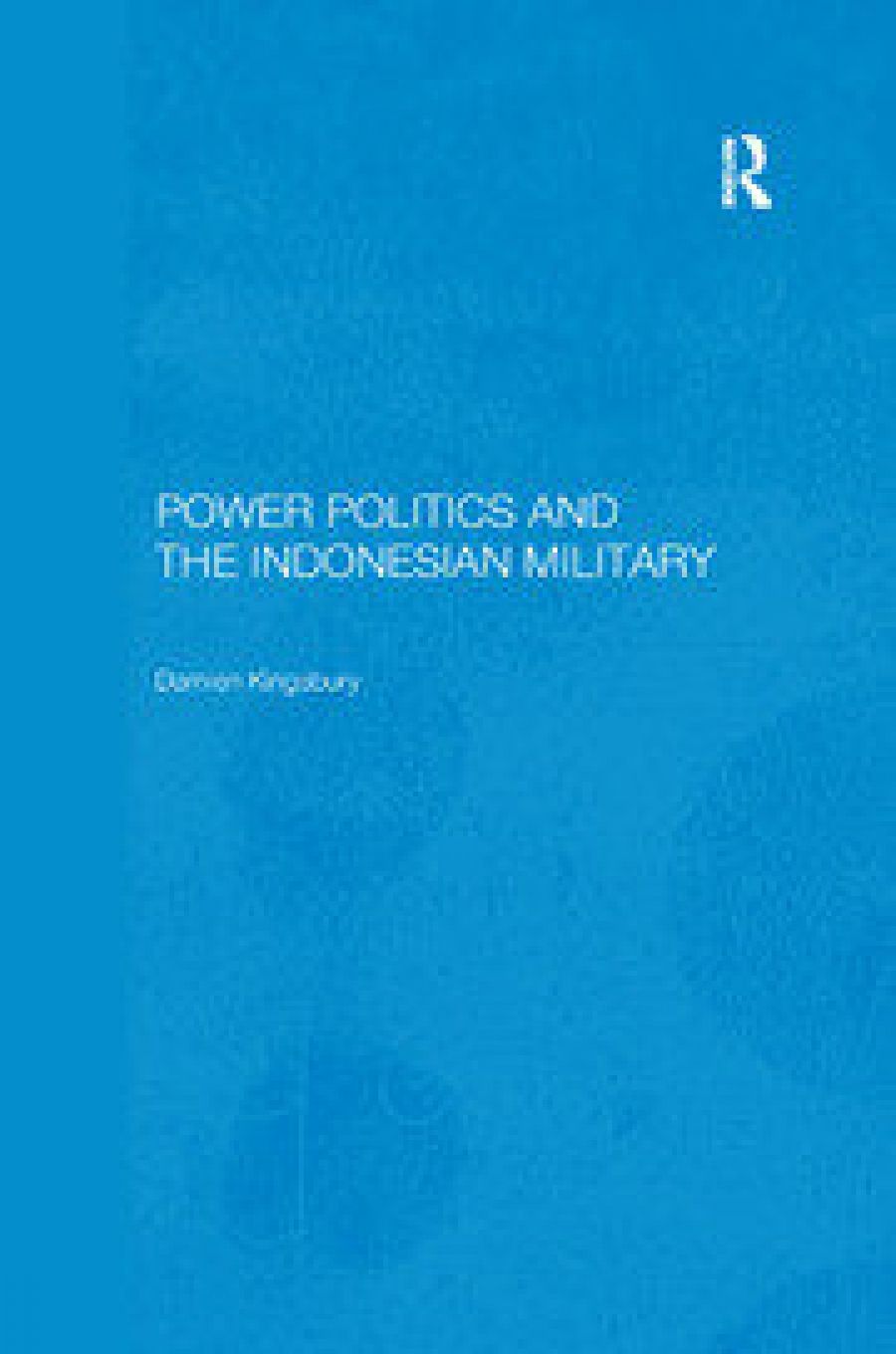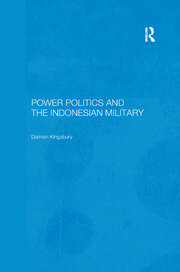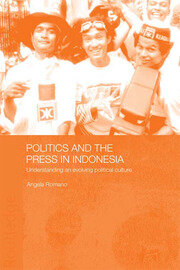
- Free Article: No
- Contents Category: Asian Studies
- Review Article: Yes
- Article Title: Hegemony of Violence
- Online Only: No
- Custom Highlight Text:
Damien Kingsbury witnessed the 1999 violence in East Timor as a UN observer, and uses the experience of being confronted with the Indonesian military’s campaign of violence there to introduce what is the most frank assessment of the Indonesian military we are likely to see outside of confidential intelligence reports. The fact that Kingsbury has experienced the fear the Indonesian military instils in places like Aceh and Ambon makes this analysis of the role of the military there so important. It is not so much the explicit writing of that experience, but the questions it makes him ask about the Indonesian military and the con-struct of the Indonesian state, that make this piece of academic writing stand out.
- Book 1 Title: Power Politics and the Indonesian Military
- Book 1 Biblio: RoutledgeCurzon $207 hb, 298 pp
- Book 1 Cover Small (400 x 600):

- Book 1 Cover (800 x 1200):

- Book 2 Title: Politics and the Press in Indonesia
- Book 2 Subtitle: Understanding an evolving political culture
- Book 2 Biblio: RoutledgeCurzon $191 hb, 239 pp
- Book 2 Cover Small (400 x 600):

- Book 2 Cover (800 x 1200):

It is almost taboo in academic or foreign policy circles in Australia to question the validity of the Indonesian state, but, by stating and analysing the glaringly obvious, Kingsbury raises important questions about the role of the Indonesian military in holding that state together by force. He recognises the inequalities in the Indonesian state that have led to Java being economically dominant at the expense of the rest of the archipelago, and how the Indonesian military maintains that. Kingsbury writes: ‘There seems to be less commitment to the idea of “Indonesia” early in the twenty-first century than there was half a century before, if one is to take as indicative the Aceh rebellion and expressions of a desire for independence in West Papua, and to some extent in Maluku Selatan, Riau and perhaps parts of Kalimantan.’ It is what is lacking in other academic writings on Indonesia. The recognition that Indonesia is a country currently held together by military force is absent from much scholarship on that country, and Kingsbury goes back to the formation of the Indonesian state and its armed forces to explain how this reality has come into being. With that assumption, Kingsbury predicts that ‘the TNI as arbiter and enforcer would continue to imply a use of violence on its behalf as a means of obtaining compliance’.
Events in Indonesia since Kingsbury finished this book last year have only reinforced his conclusion that the military under President Megawati is more powerful and involved in politics than ever. The declaration of martial law in Aceh in May, and the subsequent military operation to crush the GAM Free Aceh Movement guerrillas, have produced what is currently the highest death toll of any conflict in Asia since the operation began on May 19. The fact that the military has been able effectively to ban journalists, NGOs and human rights workers from entering Aceh, and has admitted to killing at least 600 people in the last three months without a murmur of protest from the governments of Australia or the US, indicates that their position is currently very secure. It is interesting to note that Kingsbury, who has been to Aceh and met the guerrillas, is able to convey the extent to which the Acehnese do support GAM, and why. Unlike other academics and journalists who accept the Indonesian intelligence’s slurs and half-truths regarding GAM’s criminal activities and level of support, Kingsbury is able to give a clear-eyed assessment of the military’s operations in Aceh.
Myths such as the distinction between the Indonesian police and the military in places like Aceh are debunked. Kingsbury illustrates how the police function as an extension of the state repressive network. They are important points because, in the wake of the successful Bali bombing investigation, the police stand to gain international funding and training, and their activities in places like Aceh and West Papua must be scrutinised.
Those diplomats or politicians in Australia such as Alexander Downer and Ashton Calvert, or even Defence Minister Robert Hill, who seek to excuse the outrages committed on Indonesian citizens by their own government and military, always try to absolve the hierarchy of the Indonesian military and the Indonesian state. The classic case of this was the ‘rogue elements’ theory that they used to try and explain away the violence in East Timor. But it still continues in responses to Indonesian actions in Aceh and West Papua. Recent calls by Hill to resume Kopassus training in Australia are a case in point. He says they will only be trained in counter-terrorist strategies and that this will not be applicable in their functions as counter-insurgency troops in places such as Aceh. But as Kingsbury’s book so clearly shows, the role of combating internal dissent is the primary function of Kopassus and, indeed, the whole Indonesian military structure. Supporters of Indonesia often distinguish between good and bad branches of its military. This is another myth that doesn’t stand up to Kingsbury’s examination. The marines, for example, were hailed as a neutral force in the downfall of Suharto, but they are still committing human rights abuses in Aceh. The Brimob riot police are more feared in Aceh than the military, though their funding does not attract the same controversy that the Kopassus training does. As Kingsbury writes:
To confront the Indonesian military is not merely to confront an out of control soldier or some rogue element, as is sometimes claimed; it is not even to confront an institution that is beyond the control of the state, as has also been claimed. To confront the Indonesian military is to confront an agent of the state that is at the same time also the state’s keeper.
As Kingsbury traces the role of the Indonesian military, he demonstrates how the military has controlled and shaped the successive governments of Indonesia. It is a depressing picture, but one that most commentators have shied away from. Examples of the military’s dictation of events to the government are many — from East Timor in 1975, when the military initiated destabilisation programmes without Suharto’s knowledge, to the violence of 1998–99 in East Timor. Now one can add the massive operation in Aceh.
Australian academics have not covered themselves in glory when it comes to interpreting Indonesia, which makes this book unique. The military has emerged from the so-called ‘reform period’ following Suharto’s demise as ruthless and as powerful as ever, with little intention of pursuing any kind of self-reform. The business interests and the internal workings of the Indonesian military are well documented in this book, but its major strength lies in the recognition of the simple fact that the Indonesian military rules by fear, or, as Kingsbury calls it, ‘a sort of hegemony of violence’. Removing the military from what is supposed to be a democratising Indonesia has proved impossible. As Kingsbury points out, ‘moves towards the reining in of the TNI’s power have presented a direct challenge to the state itself’. If that is the case, shouldn’t the idea of the state itself be reviewed if maintaining it amounts to de facto military rule? After reading this book, one can only conclude that that is what Megawati’s Indonesia represents.
A recent article in Tempo magazine by Indonesian journalist Goenawan Mohamad questioned the integrity of the Unitary Republic of Indonesia: ‘What is the point of any preserved “integrity” when forests are burned, rice fields and storehouses are destroyed, and a society is in a mess? What is the meaning of “integrity” when groups of people who differ from each other kill and exile one another?’
He was talking about the war in Aceh, and the military and Megawati’s constant refrain about the sacred territorial integrity of the republic and their use of it as a justification for the latest campaign. According to Angela Romano’s Politics and the Press in Indonesia, Goenawan Mohamad was the second most admired journalist in Indonesia among the journalists she surveyed. The other two nominated most frequently were also Suharto-era editors of banned publications. The message in her book is clear. To Indonesian journalists, their idols are those who pushed for freedom in the press. But the day-to-day reality of corruption, threats of violence and retribution by the authorities means that the extent they can practise that freedom is still low.
Because of his age and prestige, Goenawan Mohamad may or may not be physically assaulted or killed for writing that article critical of the military. However, if he was a young reporter in Aceh at the moment, it is highly likely he could end up like the Indonesian television reporter found floating in the river in Banda Aceh in June this year. He had disappeared in the first few days of martial law and, when his body was discovered, it showed signs of torture. It also had duct tape over the mouth, ears and eyes. It was a clear sign to journalists working in the Acehnese capital of how things were going to be under martial law.
Romano uses her surveys of journalists in Java between 1996 and 1998 as the basis for her book on Indonesian journalism. It is a look at how journalism evolved through the Suharto era, when it was referred to as the Pancasila press, in deference to the state ideology of the New Order. In what was a curiously Orwellian approach, the press was ‘granted “functional freedom” to assist in programs for improving economic and social conditions, rather than freedom from government control’. Romano notes how one of Indonesia’s security organisations, Kopkamtib, developed guidelines for this kind of reporting under an acronym: ‘MISS SARA prohibits the press from covering subjects likely to stimulate sedition, insinuation, sensation, or speculation or which might ignite ethnic, religious, racial or group tensions.’ It is an interesting back-ground into how the restrictions on the press were justified, and how the journalists themselves perceived them.
Romano examines the culture of the ‘envelope’, one of the problems that has thrived after the collapse of the New Order. Reading the restrictions placed on journalists in the Suharto era, followed by the relatively liberal Habibie and Wahid eras, one can’t help but be struck by how press freedom has regressed under Megawati — back to the values encompassed in the Pancasila press and promoted by the military. As Romano says, ‘the biggest threat to journalists are no longer laws and regulations that are designed by the executive and the parliament. Instead, physical violence is the journalist’s greatest risk’. That is why so much of the damning information in Kingsbury’s book will never be published in the Indonesian press.


Comments powered by CComment